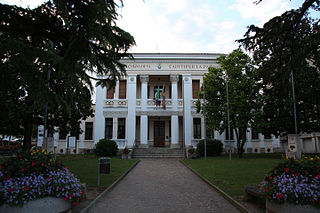Zanussi is an Italian producer of home appliances that was bought by Electrolux in 1984. Zanussi has been exporting products from Italy since 1946.

Dainese is an Italian manufacturer of protective equipment and technical gear for dynamic sports, including motorcycling, mountain biking, winter sports and horseriding. Founded in 1972 by Lino Dainese, it has expanded through organic growth and acquisitions, including Italian helmet manufacturer AGV in 2007.

Mario Bellini is an Italian architect and designer. After graduating from the Polytechnic University of Milan in 1959, Bellini pursued a career as an architect, exhibition designer, product designer, and furniture designer during the Italian economic boom of the late 20th century. Bellini has received several accolades in a variety of design fields, including eight Compasso d'Oro awards and the Gold Medal for Lifetime Achievement by the Triennale di Milano. In 2019, the Italian President of the Chamber of Deputies, Roberto Fico, awarded Bellini a career medal in recognition of his contributions to Italian architecture and design.

The Sacco chair, also known as a bean bag chair,beanbag chair, or simply a beanbag, is a large fabric bag, filled with polystyrene beans, designed by Piero Gatti, Cesare Paolini and Franco Teodoro in 1968. The product is an example of an anatomic chair, as the shape of the object is set by the user. “[The Sacco] became one of the icons of the Italian anti-design movement. Its complete flexibility and formlessness made it the perfect antidote to the static formalism of mainstream Italian furniture of the period,” as Penny Spark wrote in Italian Design – 1870 to the Present.

Cornuda is a comune with 6,276 inhabitants in the province of Treviso.

Achille Castiglioni was an Italian architect and designer of furniture, lighting, radiograms and other objects. As a professor of design, he advised his students "If you are not curious, forget it. If you are not interested in others, what they do and how they act, then being a designer is not the right job for you."

Richard Sapper was a German industrial designer who was based in Milan for much of his career. He is considered to be one of the most influential figures of post-war Italian design. His products typically feature a combination of technical innovation, simplicity of form, and an element of wit and surprise.
Antonio Citterio is an Italian architect, furniture designer and industrial designer who lives and works in Milan.

Luigi Walter Moretti was an Italian architect. Active especially in Italy from the 1930s, he designed buildings such as the Watergate Complex in Washington DC, The Academy of Fencing, and Il Girasole house, both in Rome. He was the founder of the Institute for Operations Research and Applied Mathematics Urbanism, where he developed his research on the history of architecture, and on the application of algorithmic methods to architectural design. He is recognized as the inventor of parametric architecture.

Giulio Cappellini is the founder and art director of the eponymous Italian furniture company Cappellini based in Milan. In 2004 the Company became part of the Poltrona Frau Group. In 2021, it was acquired by the American office furnisher Haworth Inc.
In 2000 Paolo Brescia and Tommaso Principi established the collective OBR to investigate new ways of contemporary living, creating a design network among Milan, London and New York. After working with Renzo Piano, Paolo and Tommaso have oriented the research of OBR towards the integration artifice-nature, to create sensitive architecture in perpetual change, stimulating the interaction between man and environment. The team of OBR develops its design activity through public-private social programs, promoting – through architecture – the sense of community and the individual identities. Today OBR is group open to different multidisciplinary contributors, cooperating with different universities, such as Accademia di Architettura di Mendrisio, Aalto University, Academy of Architecture of Mumbai and Mimar Sinan Fine Art University. Among the best known works by OBR are the Pythagoras Museum, the New Galleria Sabauda in Turin, the Milanofiori Residential Complex, the Children Hospital in Parma, the Galliera Hospital in Genoa, the Lido of Genoa, the Ex Cinema Roma, the Triennale di Milano Terrace. The under construction projects by OBR include the Lehariya Cluster in Jaipur, the Jafza Traders Market in Dubai and the Multiuse Complex Ahmad Qasir in Teheran. OBR's projects have been featured in Venice Biennale of Architecture, Royal Institute of British Architects in London, Bienal de Arquitetura of Brasilia, MAXXI in Rome and Triennale di Milano. OBR has been awarded with the AR Award for Emerging Architecture at RIBA, the Plusform under 40, the Urbanpromo at the 11° Biennale di Venezia, the honourable mention for the Medaglia d'Oro all'Architettura Italiana, the Europe 40 Under 40 in Madrid, the Leaf Award overall winner in London, the WAN Residential Award, the Building Healthcare Award, the Inarch Award for Italian Architecture and the American Architecture Prize in New York. Since 2004 OBR has been evolving its design parameters according to the environmental and energy certification LEED and since 2009 OBR is partner of the GBC.
Roberto Pezzetta is an Italian artist and industrial designer.
Flexform SpA is an Italian company with its head office in Meda, Italy, at the centre of the furniture production district of La Brianza. Founded in 1959 by the Galimberti brothers, the company designs, produces and markets furniture and furnishing accessories for residential and public use.

Afra and Tobia Scarpa are award winning postmodern Italian architects and designers. Their pieces can be found in museums across the United States and Europe, including collections in MoMA and the Louvre Museum. They have collaborated with companies such as B&B Italia, San Lorenzo Silver, and Knoll International. They have won a number of awards such as the Compasso d'Oro in 1969 to the International Forum Design in 1992. Their design work consists of architecture and everyday household items including, furniture, clothing, interior design, art glass. They focused on the technical and aesthetic possibilities of materials in their designs. The couple was greatly influenced by Tobia’s father, Carlo Scarpa, a Venetian architect and designer.
Clino Trini Castelli is an Italian industrial designer and artist. He has used the concept of "noform" through his work in environmental and industrial design, developed through the application of tools such as Design Primario and CMF design.

Setsu and Shinobu Ito are Japanese designers. Their work is stored as permanent collections in the Modern Art Museums in Munich, Germany and Milan, Italy.
Michele de Lucchi is an Italian architect and designer.
Salvatori is an Italian design brand specialising in natural stone such as marble, limestone and sandstone.

Zanotta is an Italian furniture company particularly known for the iconic pieces of Italian design it produced in the 1960s, 70s, and 80s. These include the "Sacco" bean bag chair and "Blow", the first mass-produced inflatable chair. The company was founded in 1954 and has its main plant in Nova Milanese. In 1984 Zanotta established its experimental division, Zabro, headed by Alessandro Guerriero, with Alessandro Mendini and Stefano Casciani. Since the death of its founder, Aurelio Zanotta, in 1991, it has been run by members of his family. Zanotta's products were awarded the Compasso d'Oro in 1967, 1979, 1987 and 2020.

Ernesto Gismondi was an Italian designer, founder of Artemide. Gismondi was best known for designing light fixtures.













